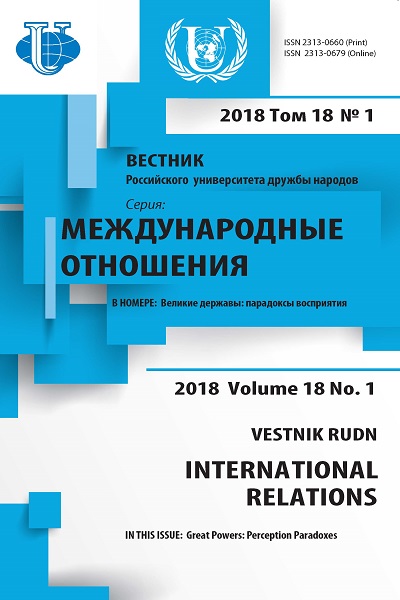Japanese young people’ perceptions of Russia
- 作者: Zhilina L.V.1
-
隶属关系:
- Dostoevsky Omsk State University
- 期: 卷 18, 编号 1 (2018): Great Powers: Perception Paradoxes
- 页面: 49-65
- 栏目: THEMATIC DOSSIER
- URL: https://journals.rudn.ru/international-relations/article/view/18376
- DOI: https://doi.org/10.22363/2313-0660-2018-18-1-49-65
如何引用文章
全文:
详细
This paper explores the dynamics of changing perceptions of Russia by Japanese young generation. The aim of the paper is to examine attitude toward Russia among young Japanese people, and to investigate factors that affect their “distant neighbor” perceptions and attitudes, and how it has changed within five years. As relations between Japan and Russia grow more complex, the need for more knowledge for mutual understanding is getting great. It is based on a series of more detailed data analyses of the polls conducted at the Universities of Japan - as a part of research project “Student’s Representations of neighboring countries at the beginning of 21st century - Russia and Japan”. In the research author turned to a student’s audience, which is most perspective for acting with, on the way of creation of public opinion about foreign countries as well. Author address findings that obtained in 2007 and 2012 and use qualitative research methods, such as interviewing and discourse analysis. So, we provide an overview of findings from representative surveys and analyze findings from studies to draw conclusions about the drivers of changing public perceptions towards Russia. Presented research is an illustrative explanation - stereotyped images are long-lasting and durable. They are difficult to change and can be passed on as heritage from the past. Author concludes that although in general at the level of the University students’ perceptions towards Russia have not been changed, but in details we can see some quantitative changes. The results indicated that some Japanese students held quite optimistic opinions toward Russia, but there was also evidence that public opinions toward Russia differed across the students and sometimes not in positive way.
作者简介
Larisa Zhilina
Dostoevsky Omsk State University
编辑信件的主要联系方式.
Email: larissa-zhilina@yandex.ru
PhD in History, Associate Professor of the Dostoevsky Omsk State University
参考
- Castano, E., Bonacossa, A. & Gries, P. (2015). National Images as Integrated Schemas: Subliminal Primes of Image Attributes Shape Foreign Policy Preferences. Political Psychology, 37(3), 351-366. doi: 10.1111/pops.12259.
- Chugrov, S.V. (2017). The Image of Russia in Japan and the Image of Japan in Russia: Working Paper 33/2017. Russian International Affairs Council (RIAC). Moscow: NPMP RIAC.
- Feklyunina, V. (2009). National Images in International Relations: Putin’s Russia and the West. Thesis PhD in Politics. University of Glasgow.
- Herrmann, R.K. & Fischerkeller, M.P. (1995). Beyond the Enemy Image and Spiral Model: Cognitive-Strategic Research after the Cold War. International Organization, 49 (3), 415-450.
- Klapper, J.T. (1960). The Effects of Mass Communication. NY: Free Press.
- Katz, E. (1961). The Social Itinerary of Technical Change: Two Studies on the Diffusion of Innovation. Human Organization, 20(2), 70-82.
- Kholodkovsky, K.G. (1979). Some questions of the development of political mass consciousness. World Economy and International Relations, 6, 126-131. (In Russ.).
- Kunczik, M. (1997). Images of Nations and International Public Relations. Mahweh, N.J.: Lawrence Erlbaum.
- Li, X. & Chitty, N. (2009). Reframing national image: A methodological framework. Сonflict & communication online, 8(2), 1-11.
- Scott, W.A. (1966). Psychological and social correlates of international images. In: International Behavior. Ed. by H.C. Kelman. NY: Holt, Rinehart and Winston, p. 70-103.
- Sears, D.O. & Freedman, J. (1967). Selective Exposure to Information: A Critical Review. Public Opinion Quarterly, 31, 194-214.
- Tichenor, P.J., Donohue, G.A. & Olien, C.N. (1970). Mass media flow and differential growth in knowledge. Public Opinion Quarterly, 34 (2), 159-170.
- Whitehead, S. (1987). Arab Portrayals in U.S. and British News Magazines: A Comparative Analysis. Paper presented at the Annual Meeting of the Association for Education in Journalism and Mass Communication.
- Yehuda, A. (1976). The role of intergroup contact in change of prejudice and ethic relations. In: Towards the elimination of racism. Ed. by Katz P.A. NY: Pergamon, p. 245-308.
- Youichi, I. (1991). Socio-cultural backgrounds of Japanese interpersonal communication style. Civilisations, 39, 101-128.
- Zhilina, L.V. (2008). Representations of neighboring countries at the beginning of 21st century - Russia and Japan in students’ imaginations. Omsk: Omskblankizdat.
- Zhilina, L.V. (2009). The forming of Japanese public opinion about Russia and the Russians at the beginning of the 21st century. Herald of Omsk University, 3, 193-199. (In Russ.).
- Zhilina, L. (2015). Public attitude and mutual perceptions: Japan and Russia. CEU Political Science Journal, 10 (1-2), 1-30. (In Russ.).








